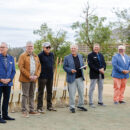PLAYING TO OUR STRENGTHS

By singing its own praises a little louder, the game can do itself a lot of good
By Kevin Fitzgerald Director, Public Affairs
Southern California’s golf facilities are enjoying record levels of participation while at the same time dealing with record levels of political challenges. You’re probably thinking — tell me something I don’t know. But since a week never passes without my being asked about the current state of our game, or about its future viability in California, I am going to attempt to shed some light on what I trust you recognize is a rather complicated question by reducing it to three simpler ones: What are the game’s strengths? What are the game’s weaknesses? And how do the game’s relationships with various recreational, environmental and business interests accrue to its benefit — or as the case may be, its detriment?
Golf’s overriding strength is the value that the game itself provides. Golf’s greatest political strength is that roughly 3.1 million Californians play it. Its biggest weakness is that it requires large tracts of highly valuable land. Its greatest political weakness is that it’s isolated.
Golf is primarily a recreation; however, it’s not particularly well integrated within the greater recreational community. Whether the Public Golf Endangerment Acts, legislation to put California on permanent standard time or repurposing schemes to replace normative golf with entertainment golf complexes or other recreational amenities — all of those issues that affected recreational interests well beyond golf — the game was left to fend for itself.
Golf is rightly proud of the great progress it has made in reducing its water footprint, reducing its use of nonorganic inputs and otherwise implementing environmentally sustainable practices, but it would be a stretch to suggest that it has reached out to align much of that good work with the greater environmental community.
There have been, and continue to be, numerous efforts to “rewild” golf courses and other managed active recreational landscapes (Sepulveda, Mission Bay, Mesquite and Tahquitz Creek, among many others), efforts that might have less oxygen were the game’s real environmental record better understood. Golf courses provide numerous environmental benefits in urban and suburban areas in the forms of green spaces that mitigate the urban heat-island effect, permeable landscapes that aid in flood management and groundwater recharge, firebreaks that stall the progress of wildfires, sites for flora and wetlands that act as carbon sinks and habitats for pollinators — all benefits desperately needed in California’s densely packed urban/suburban environments, particularly in those environments deemed “park poor.”
Perhaps not the kinds of benefits provided by the land preserves that dot and surround “park rich” and otherwise affluent areas, but from an environmental perspective certainly better than the hardscape and strip malls that would otherwise be where those golf courses are today.
Golf is a business, but its interests and the interests of the business community often conflict. Numerous privately owned golf courses and practice facilities in the state’s urban, suburban and exurban areas have been or are being considered for commercial/residential development. The value of golf’s land is just too tempting an opportunity to ignore.
Golf is more prey to be hunted than a species to preserve. Examples of that phenomenon aren’t hard to find: Weddington, Royal Vista, Oak Creek and Glen Annie, to name just a few.
If you’re wondering whether golf’s leadership organizations are working to forge alliances with these recreational, environmental and business interest groups, or whether such alliances are even capable of securing a more positive future for the golf community, my answer is a series of yesses, nos and maybes. Yes, with respect to similarly situated and interested recreational groups, where there is much to be gained but where we still have a long way to go. No, with respect to the business community; golf’s strengths are not economic. Maybe, with respect to environmental interests, some of which align well with golf, particularly those focused on water conservation and urban parkland, and others not so much.
Golf’s leadership organizations often claim that the game’s fate lies in the hands of the 90 percent who don’t play the game as opposed to the 10 percent who do. To the degree to which the claim is true, and I subscribe to that truth, it’s critical to recognize that the decisions of the 90 percent will necessarily depend upon the efficacy of the advocacy efforts of the 10 percent.
Golf’s greatest asset is its players — those who invest in the game through their green fees and club dues. When they advocate for the game, they don’t ask the powers that be to give them something; they ask only that they continue to be allowed to invest in something that brings them joy and their communities great value.
Play to strengths; buttress weaknesses. The rest is commentary … and a lot of hard work.











